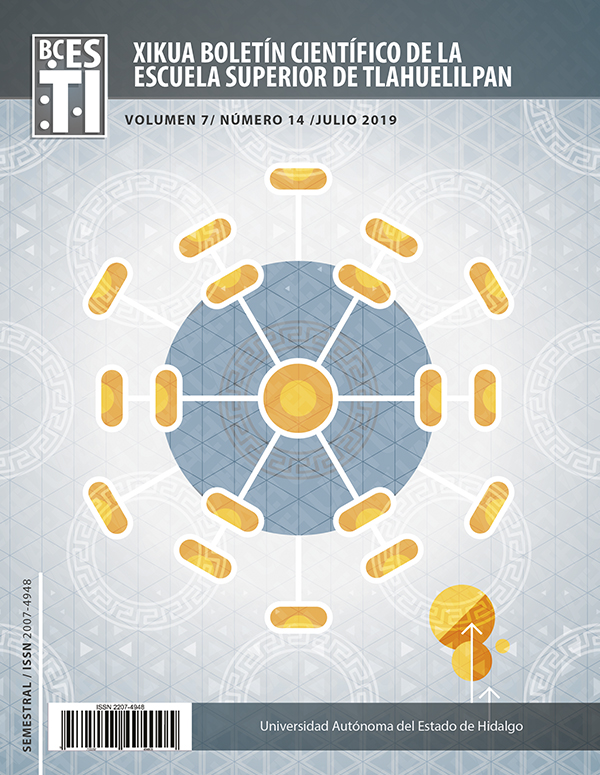La Diadema EMOTIV EPOC+ y los gestos faciales
DOI:
https://doi.org/10.29057/xikua.v7i14.4353Palabras clave:
sinapsis, electroencefalograma, señales cerebrales, sistema de interfaz, cerebro-computadoraResumen
Este artículo describe el estado del arte donde se muestra los avances de las investigaciones de los distintos dispositivos inalámbricos de emisión de electroencefalograma (EEG). También se muestra un software prototipo que interpreta las señales cerebrales que provienen de la diadema Emotiv Epoc, este proceso es llamado Interface Cerebro Computadora (ICC) o BCI (por sus siglas en inglés Brain Computer Interface) que resuelve el problema de identificación de señales EEG. El software es diseñado en Matlab y Simulink que interpreta las señales cerebrales, estas señales se pueden guardar o manipularlas en tiempo real. El software convierte las señales cerebrales a voltaje para manipular dispositivos manipuladores externos. Actualmente este trabajo está en la fase de pruebas experimentales en seres humanos y se emplea el método de adquisición de la señal no invasivo. Algunos resultados experimentales de la diadema Emotiv Epoc. Este artículo se muestra las señales que emite la diadema de los gestos faciales tales parpadeos, apretar la mandíbula, fruncir la nariz y giñar un ojo. Se espera que este trabajo ayude a personas que no tengan movimiento de su cuerpo y no puedan hablar, a manipular objetos e interpretar a través de sus gestos faciales con la diadema.
Descargas
Información de Publicación
Perfiles de revisores N/D
Declaraciones del autor
Indexado en
- Sociedad académica
- N/D
Citas
Alera, R., Vega, A., Galván, I. y Nebro, A. (2012). Multi-objective metaheuristics for preprocessing EEG data in brain–computer interfaces. J Eng Optimiz. Vol. 44. Issue 3. Pp. 373-390.
Birbaumer, N., Ghanayim, N., Hinterberger, T., Iversen, I., Kotchoubey, B., Kübler, A., Perelmouter, J., Taub, E. y Flor, H. (1999) A spelling device for the paralysed. Nature, 398:297–298.
Casadio, M., y Sanguineti, V. (2012). Learning, Retention, and Slacking: A Model of the Dynamics of Recovery in Robot Therapy. IEEE Transactions on Neural Systems and Rehabilitation Engineering . Vol. 20, Issue 3.
Crowley, K., Sliney, A., Pitt, I. y Murphy, D. (2010). Evaluating a brain-computer interface to categorise human emotional response, Proceedings of the IEEE 10th International Conference Advance Learning Technology. Pp. 276–278.
Dornhege, G., Krauledat, M., Müller, K., Blankertz, B. (2007). General signal processing and machine learning tools for BCI. Toward Brain-Computer Interfacing. Cambridge MIT Press. pp. 207-233.
Drake, C., Gumenyuk, V., Jefferson, C., Kick, A., Coaker, M. and Roth, T. (2010). Extending time in bed in short sleepers: Effects on objective sleep parameters measured in the home, Sleep. Vol. 33.
Emotiv. (2019). [Online]. Disponible: http://www.emotiv.com. [Fecha de consulta: Abril, 2019].
Figueroba, A. (2019) Los homúnculos sensorial y motor de Penfield. NEUROCIENCIAS. [Online]. https://psicologiaymente.com/neurociencias/homunculos-penfield [Fecha de consulta: Abril, 2019].
Graimann, B., Allison, B., Pfurtscheller, G. (2010). Brain-Computer Interfaces: Revolutionizing Human Computer Interaction. Brain-Computer Interfaces: Chapter A Gentle Introduction. Springer.
Kawato Mitsuo. (2008). From ‘Understanding the Brain by Creating the Brain’ towards manipulative neuroscience. Philosophical Transactions of the Royal Society. Biological Sciences.
Kennedy, P. y Bakay, R. (1998). Restoration of neural output from a paralyzed patient by a direct brain connection. NeuroReport. Vol 9. Issue 8. Pp. 1707–1711.
Liao, L., Lin, Ch., McDowell, K., Wickenden, A., Gramann, K. Jung, T., Ko, L., Chang, J. (2012). Biosensor Technologies for Augmented Brain–Computer Interfaces in the Next Decades. Proceedings of the IEEE. Vol. 100.
Millán, J., Renkens, F., Mouriño, J. y Gerstner, W. (2004). Brain-actuated interaction. Artificial Intelligence. Vol. 159. Pp. 241–259.
Mitsuo Kawato. 2008. Brain controlled robots, HFSP Journal, 2:3, 136-142.
Maura Casadio, Rajiv Ranganathan & Ferdinando A. Mussa-Ivaldi. 2012. The Body-Machine Interface: A New Perspective on an Old Theme, Journal of Motor Behavior, 44:6, 419-433.
Hornero, R., Corralejo, R. y Álvarez, D. 2012. Brain-Computer Interface (BCI). Aplicado al entrenamiento cognitivo y control domótico para prevenir los efectos del envejecimiento.
Wolpaw,J., Birbaumerc, N., McFarlanda, D., Pfurtschellere, G. Vaughana, T. (2002). Brain–computer interfaces for communication and control. Clinical Neurophysiology. ELSEVIER. Pp. 767–791.


















